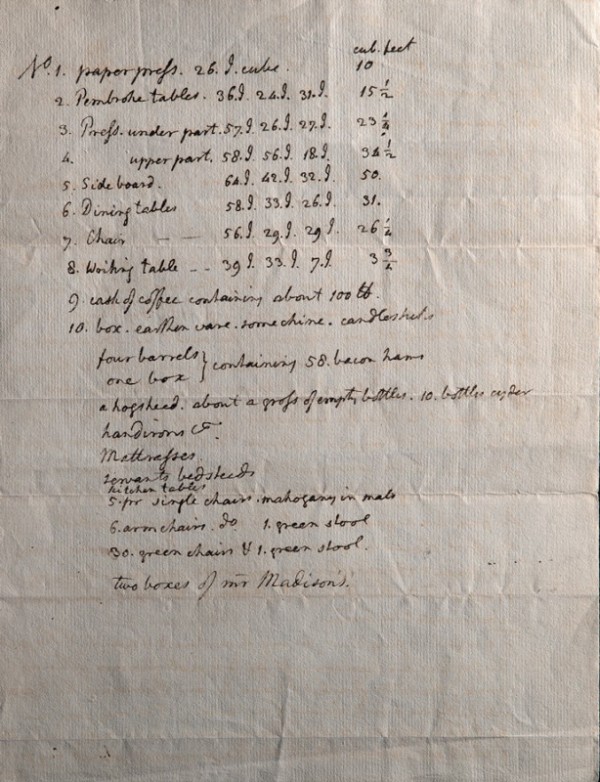
Thomas Jefferson, packing list, New York City, August 31, 1790. Pen and ink on paper. (©Thomas Jefferson Foundation at Monticello; photo, Gavin Ashworth.)
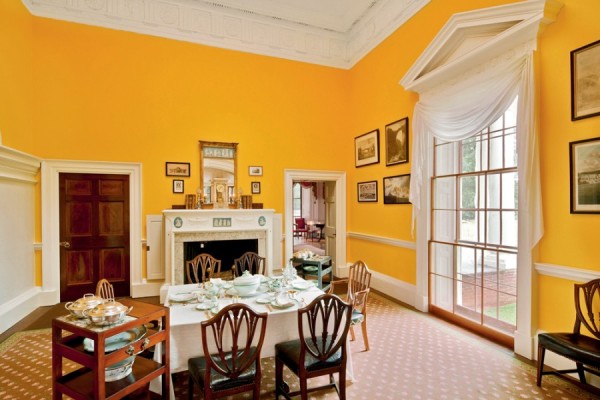
Dining room at Monticello, Albemarle County, Virginia. (©Thomas Jefferson Foundation at Monticello; photo, Philip Beaurline.) The side chairs are attributed to Thomas Burling, New York City, 1790.
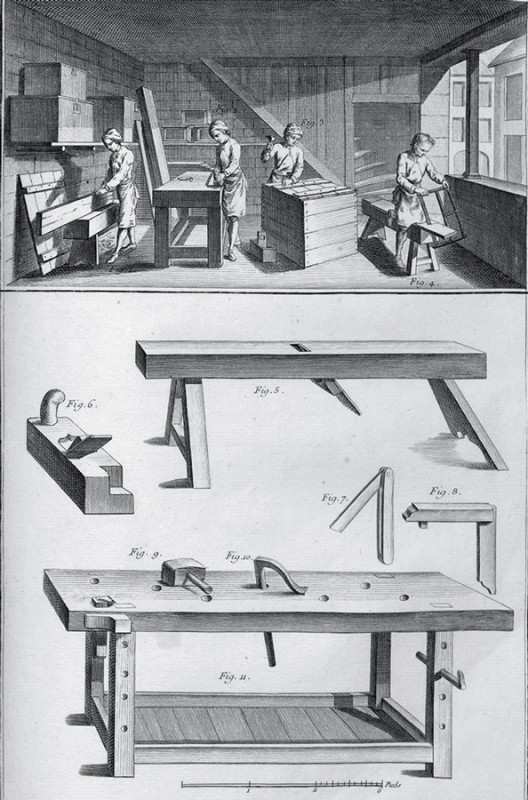
Louis-Jacques Goussier, «Layetier,» Supplément à l’Encyclopédie ou Dictionnaire raisonné des sciences, des arts et des métiers, vol. 5 (Paris: Chez Briasson, 1762–1772). (Courtesy the ARTFL Encyclopédie Project, University of Chicago.)
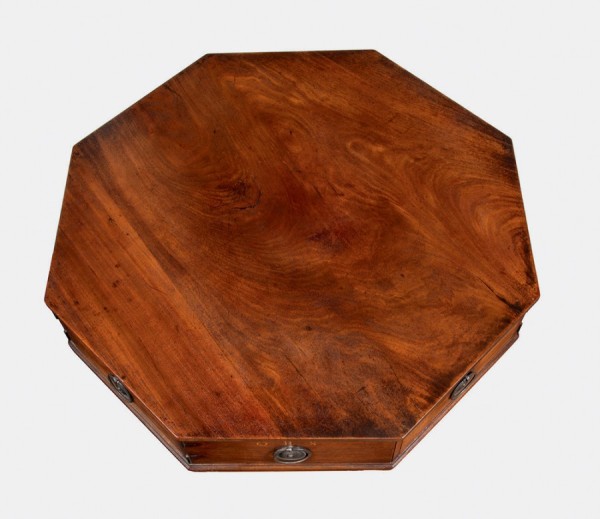
Detail showing the octagonal top of a writing table attributed to New York City cabinetmaker Thomas Burling. (Collection of the Massachusetts Historical Society; photo, Gavin Ashworth.)
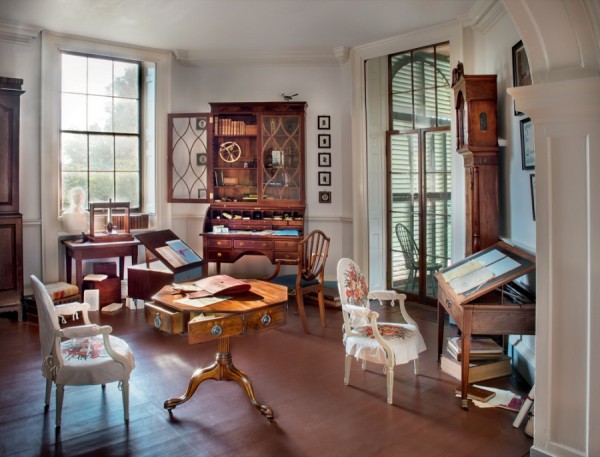
Library at Monticello, Albemarle County, Virginia. (©Thomas Jefferson Foundation at Monticello; photo, Gavin Ashworth.) The writing table and armchair with Thomas Jefferson’s shipping brand were likely used in this room.
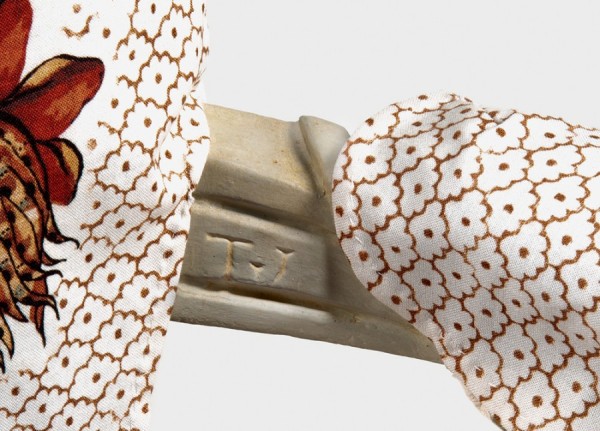
Detail of Thomas Jefferson’s shipping mark branded on the arm of a chair packed and shipped from France. (©Thomas Jefferson Foundation at Monticello; photo, Gavin Ashworth.)
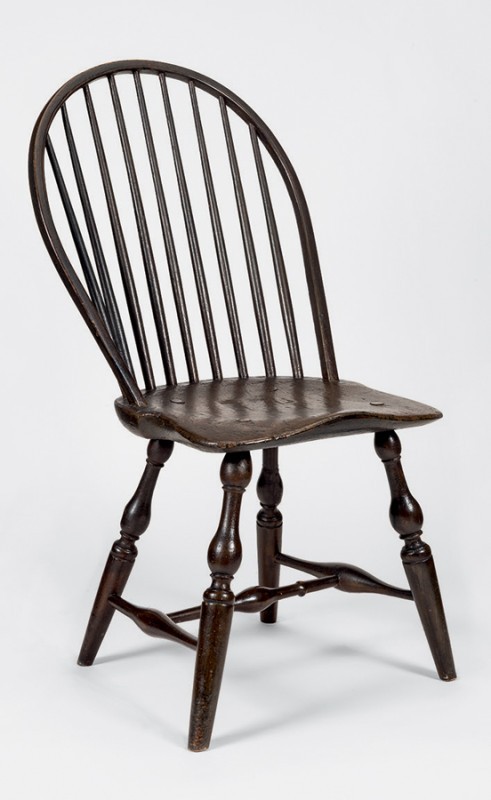
John Always, side chair, New York City, ca. 1790. Tulip poplar (seat), soft maple (left rear leg), maple (medial stretcher), and hickory (center spindle and back rail). H. 35 5/8", W. 18 3/4", D. 20 1/4".(Courtesy, Winterthur Museum.)
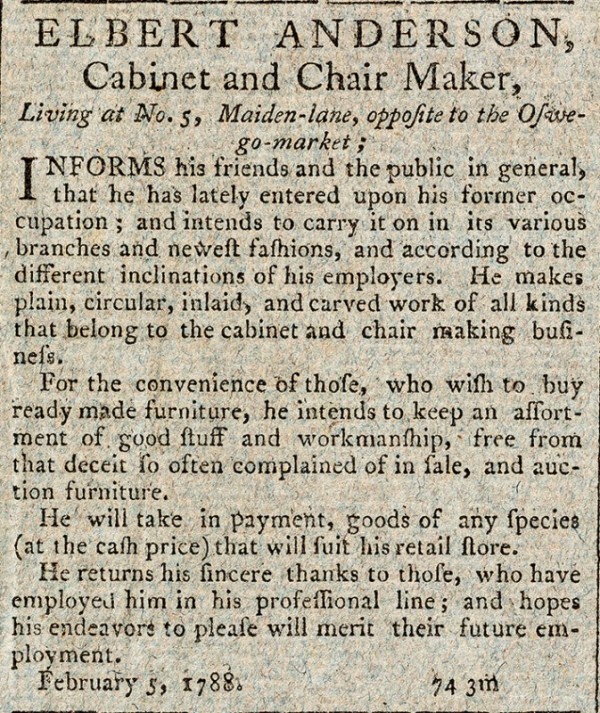
Advertisement for Elbert Anderson, New-York Packet, February 8, 1788. (Courtesy, American Antiquarian Society.)
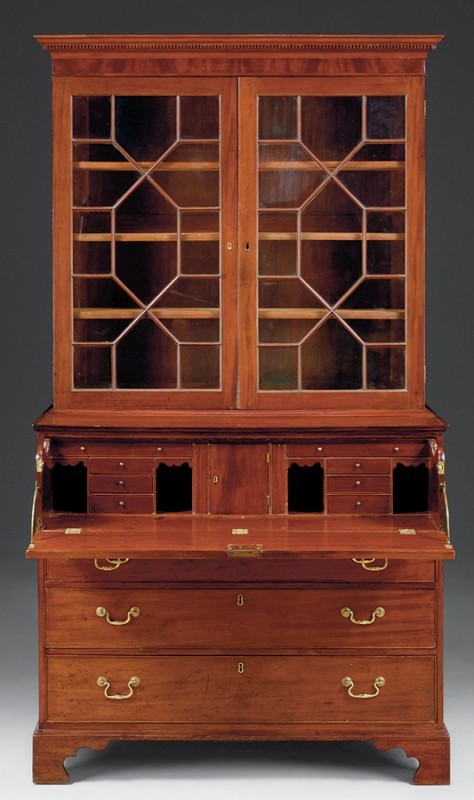
Elbert Anderson, secretary-andbookcase, New York City, 1786–1796. Mahogany with unidentified secondary woods. H. 88 7/8", W. 49 3/4", D. 24 1/4". (Courtesy, Christie’s.)
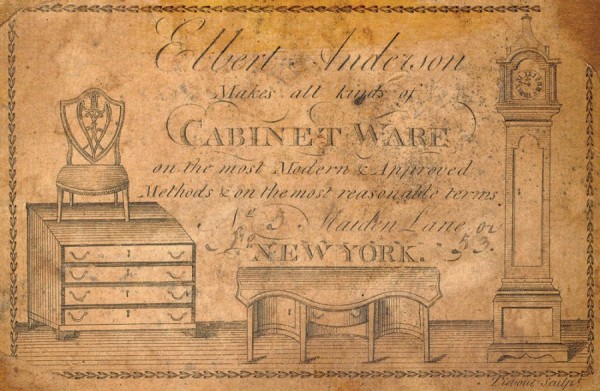
Detail of the label on the secretary-and-bookcase illustrated in fig. 9 (Courtesy, Christie’s).
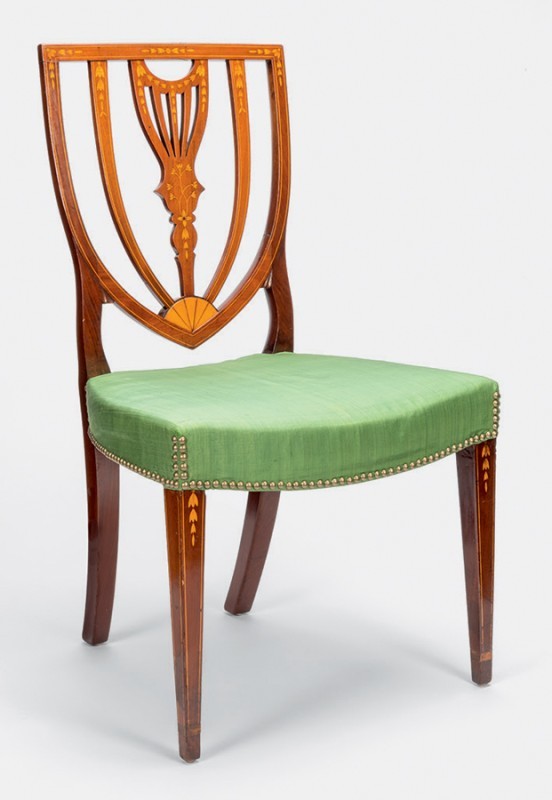
Elbert Anderson, armchair, New York City, 1790–1800. Mahogany with beech and maple. H. 36 3/8", W. 21", D. 19 7/8". (Courtesy, Winterthur Museum.) This chair is part of a large set ordered by Alexander and Elizabeth Schuyler Hamilton.
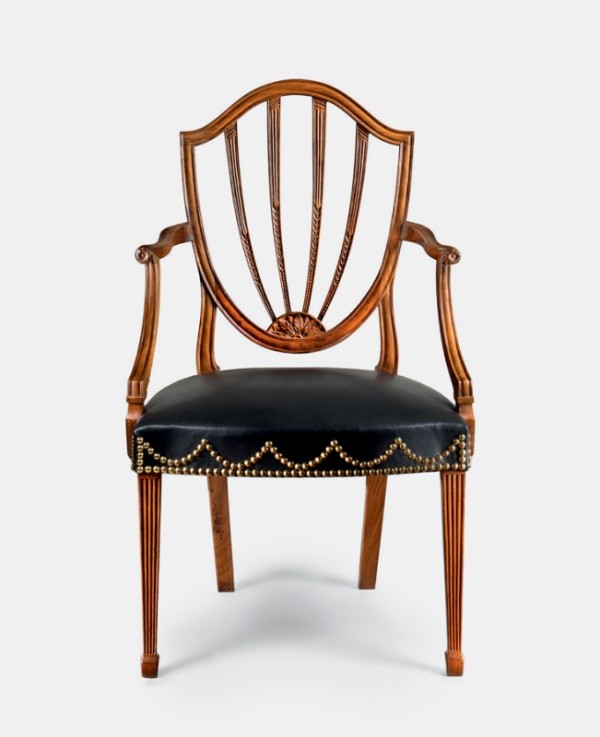
Armchair, attributed to Elbert Anderson, New York City, 1790. Mahogany with hackberry or elm. H. 37 3/4", W. 21 3/4", D. 18 1/4". (©Thomas Jefferson Foundation at Monticello; photo, Gavin Ashworth.)
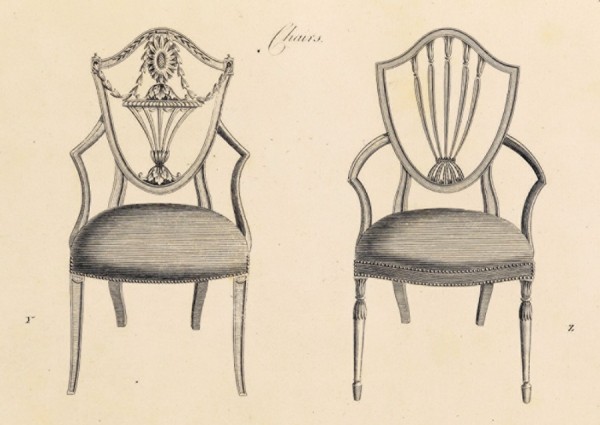
Design for “Chairs” illustrated on pl. 9 in George Hepplewhite’s Cabinet-Maker and Upholsterer’s Guide (1788). (Courtesy, Winterthur Museum.)
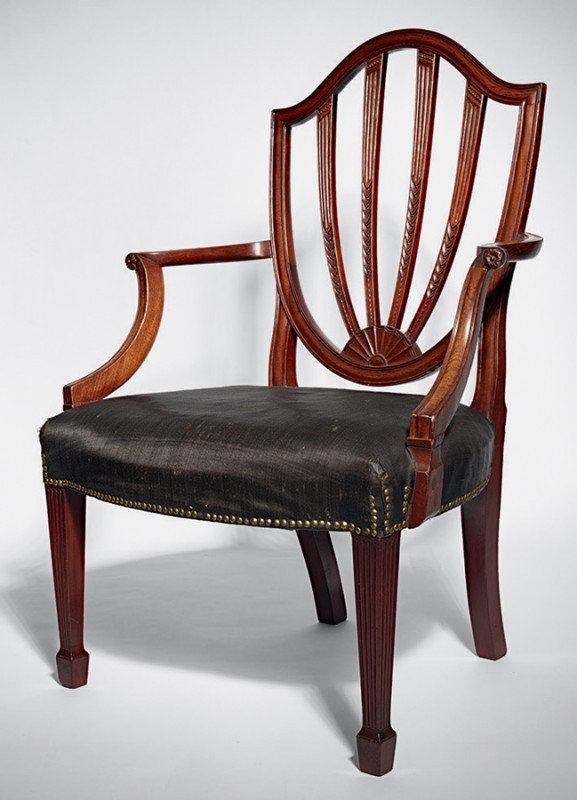
Armchair attributed to Thomas Burling, New York City, ca. 1790. Mahogany with oak. H. 40", W. 28", D. 17". (Courtesy, Division of Cultural and Community Life, National Museum of American History, Smithsonian Institution.)
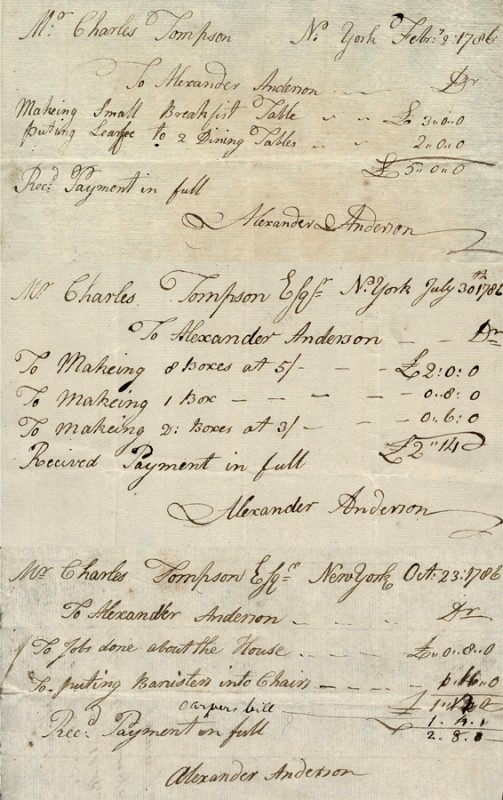
Alexander Anderson to Charles Thomson, invoice dated February 2, 1786. Ink on paper. (Courtesy, Historical Society of Pennsylvania.)
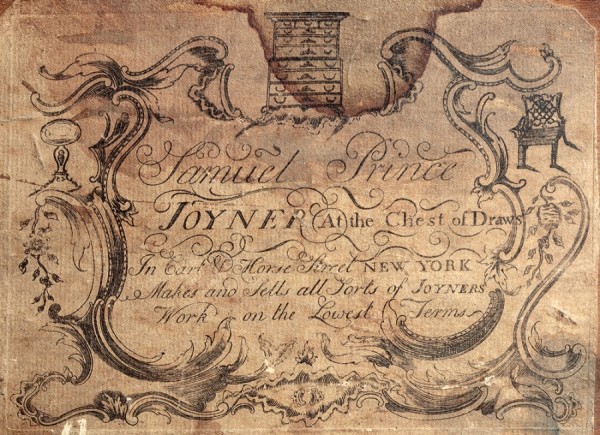
Label of Samuel Prince, New York City, ca. 1765–1775. Ink on paper. (Courtesy, Levy Galleries, New York.
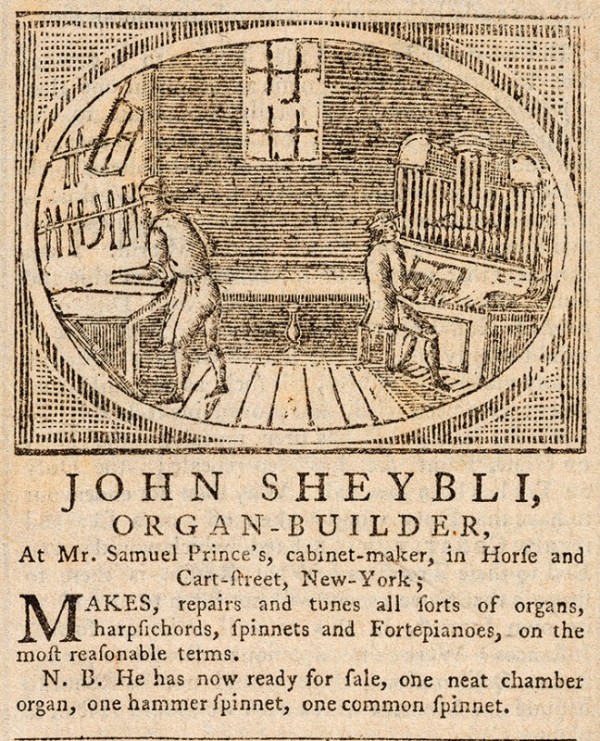
Advertisement for John Sheybli, New-York Gazette and Weekly Mercury, October 10, 1774. (Courtesy, American Antiquarian Society.)
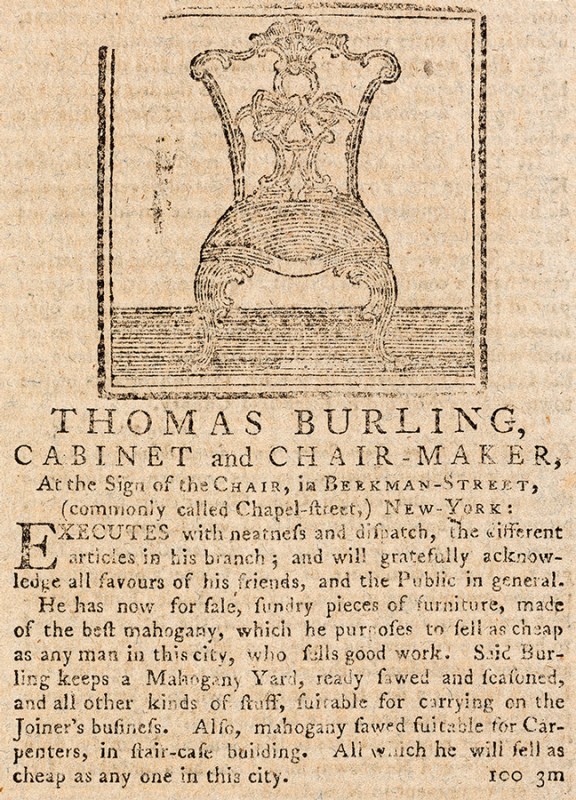
Advertisement for Thomas Burling, Rivington’s New-York Gazetteer, March 16, 1775. (Courtesy, American Antiquarian Society.)
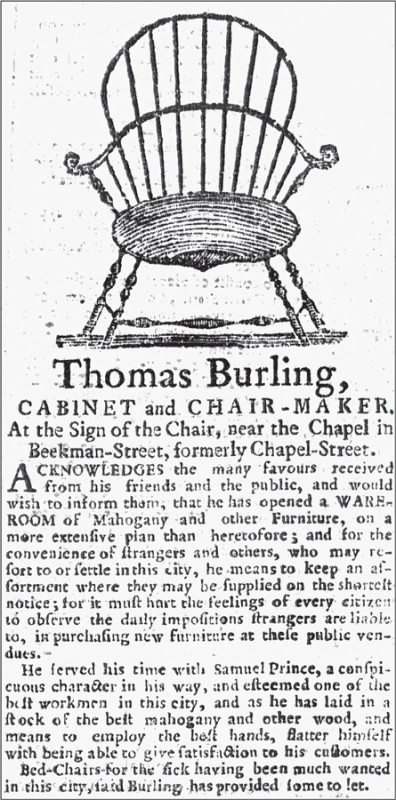
Advertisement for Thomas Burling, Daily Advertiser, Political, Historical and Commercial (New York), November 16, 1786. (Courtesy, NewsBank/Readex.)
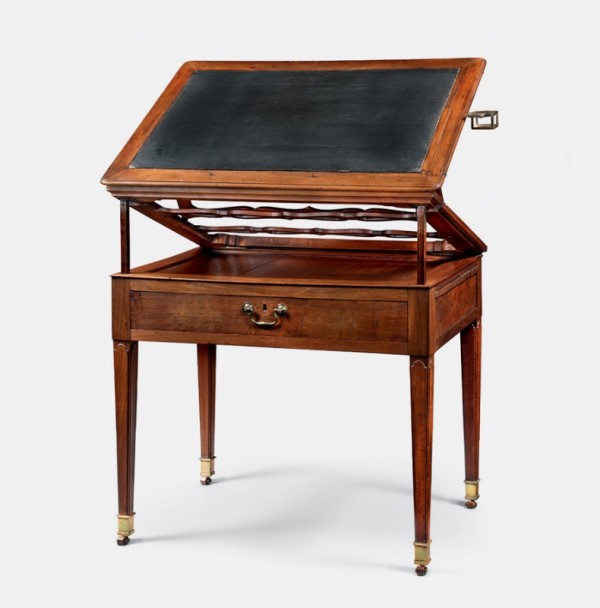
Denis-Louis Ancellet, table à la tronchin, Paris, ca. 1780. Mahogany with oak. H. 27 1/4" (closed), W. 34", D. 23". (©Thomas Jefferson Foundation at Monticello; photo, Gavin Ashworth.)
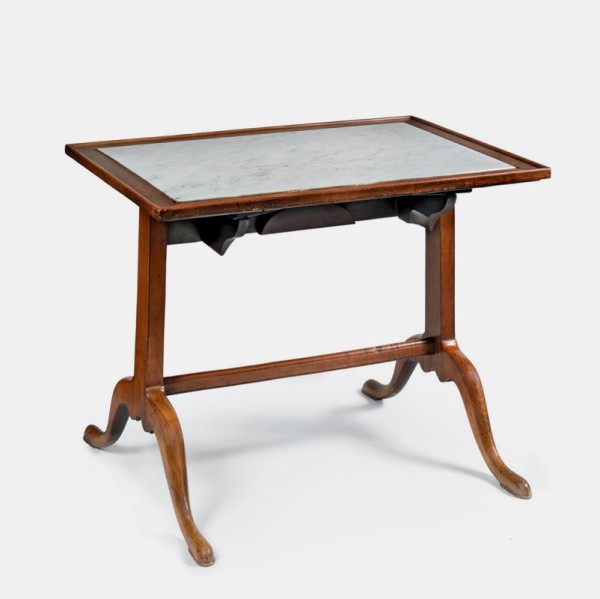
Table, possibly by Jacques Upton, Paris, ca. 1785–1789. Mahogany, oak, marble. H. 29 1/2", W. 30 3/8", D. 29". (©Thomas Jefferson Foundation at Monticello; photo, Gavin Ashworth.) This table is one of a pair.
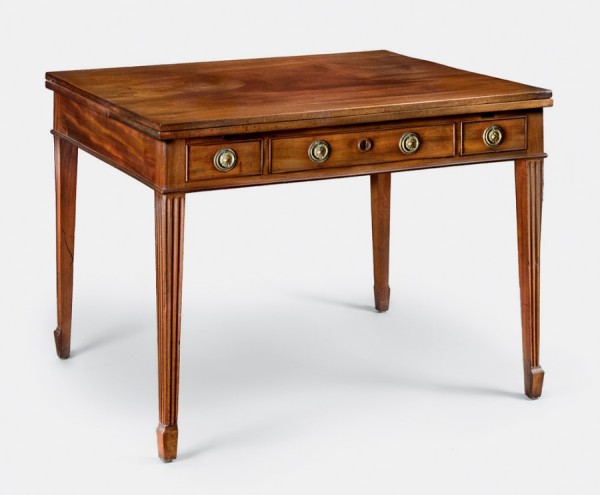
Samuel Tilt, universal table, London, 1790. Mahogany, oak, brass. H. 27", W. 36", D. 29 1/2". (©Thomas Jefferson Foundation at Monticello; photo, Gavin Ashworth.)
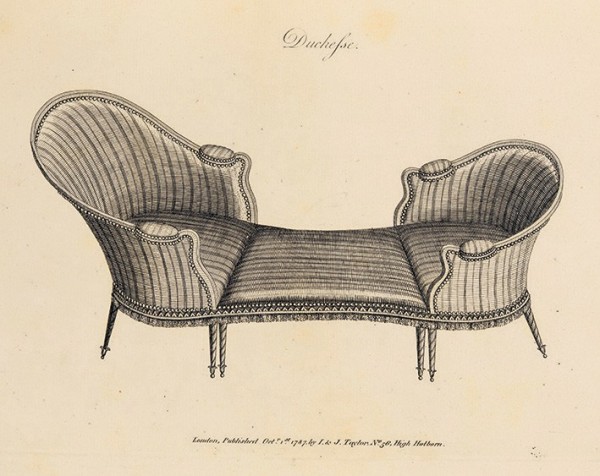
Design for “Duchesse” illustrated on pl. 28 in George Hepplewhite’s Cabinet-Maker and Upholsterer’s Guide (1788). (Courtesy, Winterthur Museum.)
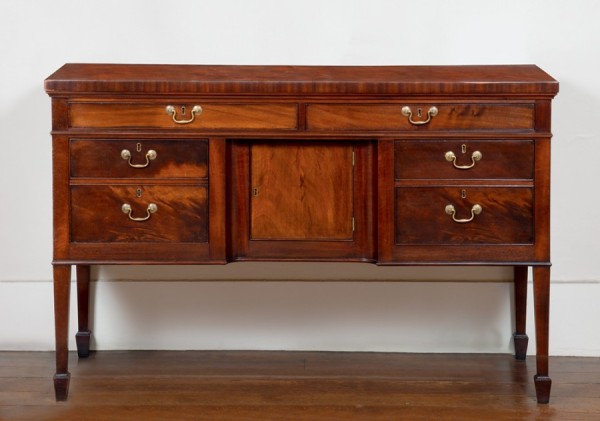
Harrison Higgins Jr., sideboard, Richmond, Virginia, 2009. Mahogany. H. 37",W. 60", D. 23 1/2". (©Thomas Jefferson Foundation at Monticello; photo, Gavin Ashworth.)
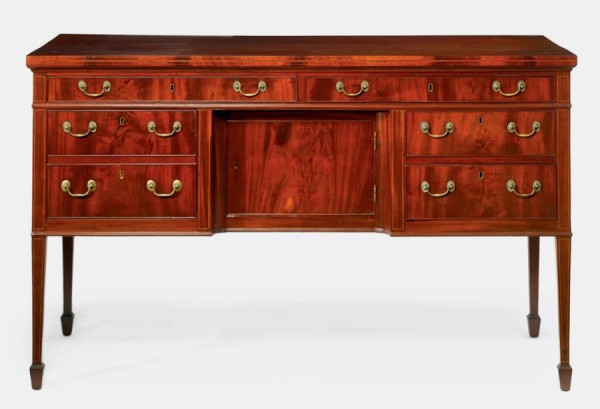
Thomas Burling, sideboard, New York, ca. 1790. Mahogany with unidentified secondary woods. H. 38 1/4", W. 64 1/4", D. 26 3/4". (Courtesy, Sotheby’s.)
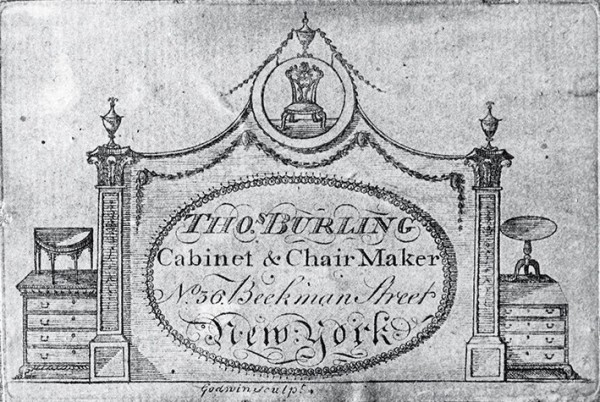
Label of Thomas Burling, New York City, ca. 1786–1793. Engraving on paper.(Courtesy, Museum of Early Southern Decorative Arts, Old Salem Museum and Gardens, WinstonSalem, North Carolina.)
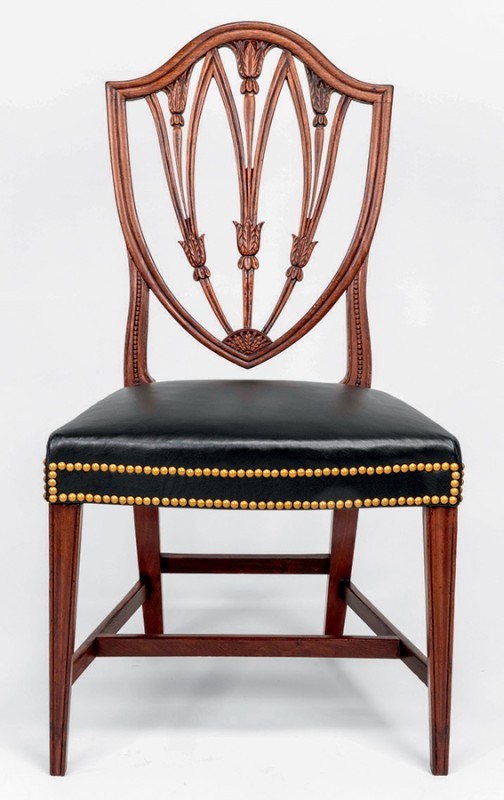
Thomas Burling, side chair, New York City, 1790. Mahogany with oak. H. 36", W. 20 1/2", D. 16 1/2". (©Thomas Jefferson Foundation at Monticello; photo; F. Carey Howlett.)
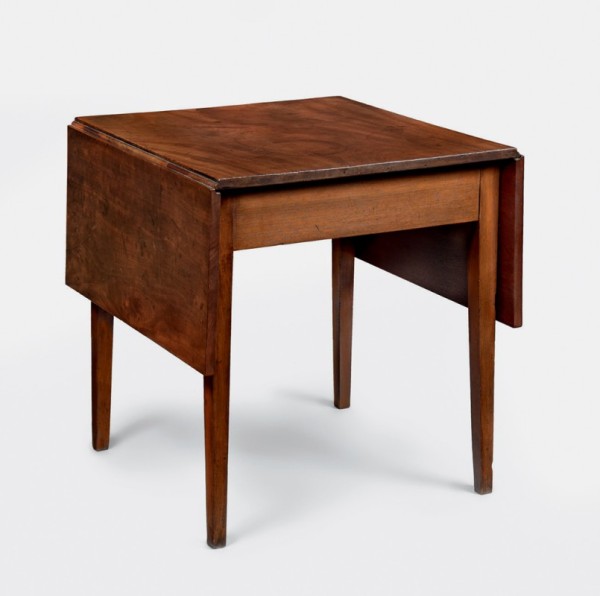
Pembroke table, attributed to James Dinsmore and John Hemmings, Monticello, Albemarle County, Virginia, 1807. Mahogany with yellow pine and cherry. H. 27 7/8", W. 26 1/8", D. 26 7/8". (©Thomas Jefferson Foundation at Monticello; photo, Gavin Ashworth.)
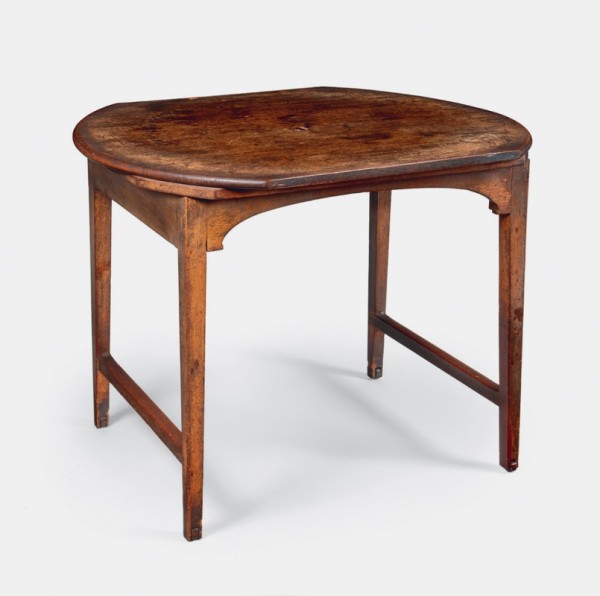
Writing table, attributed to the joiner’s shop, Monticello, Albemarle County, Virginia, ca. 1798. Mahogany. H. 29 1/2", W. 37 1/4", D. 29 7/8". (©Thomas Jefferson Foundation at Monticello; photo, Gavin Ashworth.) The base of this table may have been made in Thomas Burling’s workshop.
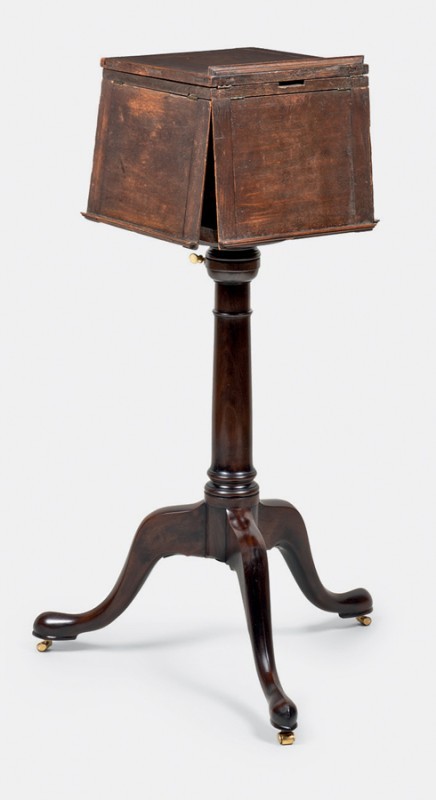
Upper section of a reading stand, attributed to Thomas Burling, New York City, 1790. Walnut. Dimensions closed: H. 11", W. 13 3/4", D. 14 1/4". (©Thomas Jefferson Foundation at Monticello; photo, Gavin Ashworth.) The tripod base is modern.
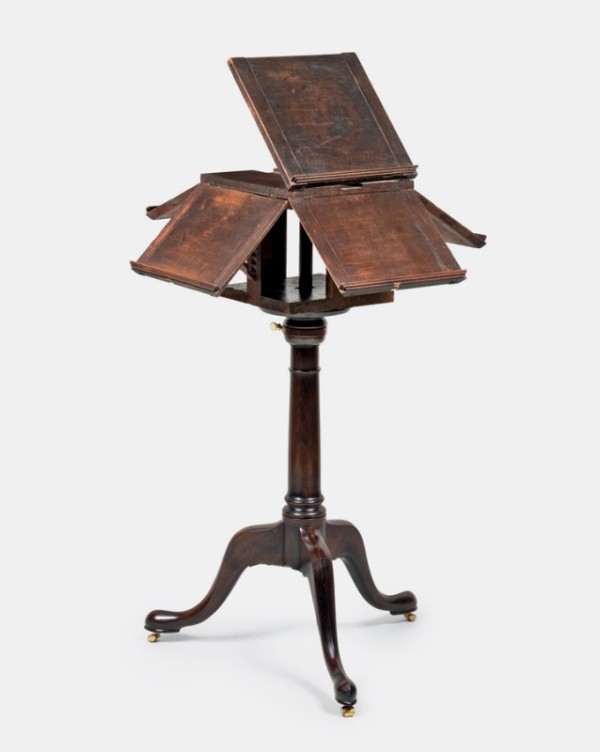
Reading stand illustrated in fig. 30, opened. (Photo, Gavin Ashworth.)
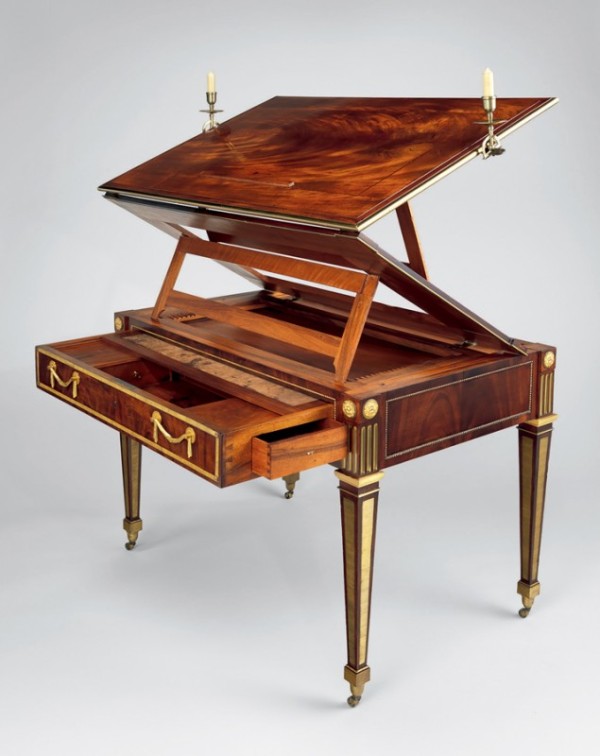
David Roentgen, table à la tronchin, Neuweid or Paris, 1780–1795. Mahogany, mahogany veneer, walnut, and cherry, with oak and pine; bronze, brass, iron, and steel. H. 31 7/8", W. 44 1/8", D. 27 1/2". (Courtesy, Cooper-Hewitt Design Museum, Smithsonian Institution.)
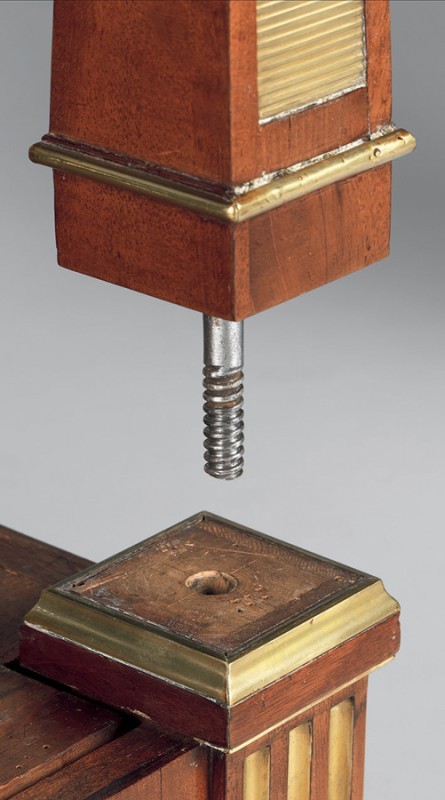
Detail of a detachable leg on a game table, attributed to David Roentgen, Neuweid or Paris, 1780–1783. (Courtesy, Metropolitan Museum of Art.)
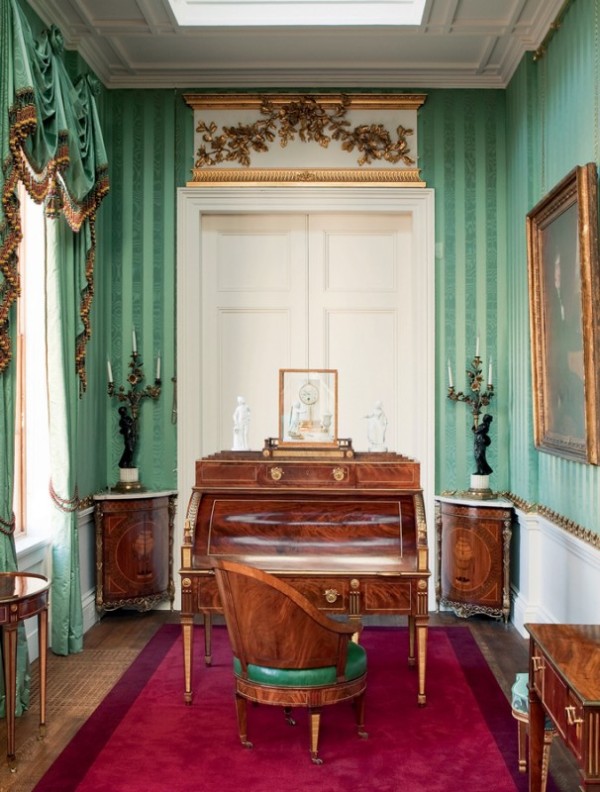
David Roentgen, bureau a cylinder and fauteuil de bureau at Chatsworth House, Neuweid or Paris, 1783–1784. Unidentified wood, mahogany, gilt bronze, leather. (Reproduced by permission of Chatsworth Settlement Trustees/Bridgeman Images.)
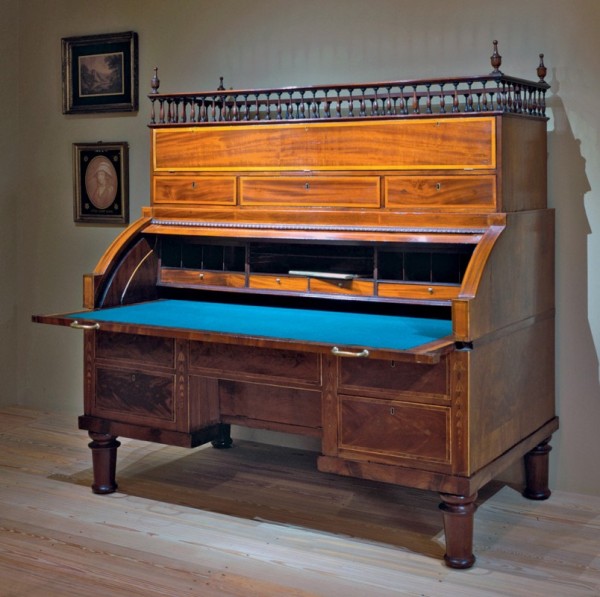
Thomas Burling, cylinder desk, New York City, 1789. Mahogany, mahogany veneer with pine, and maple. H. 66", W. 62”, D. 35". (Courtesy, Atwater Kent Collection at Drexel University, The Historical Society of Pennsylvania Collection; photo, Robert C. Lautman.) The replacement legs are shorter than the originals.
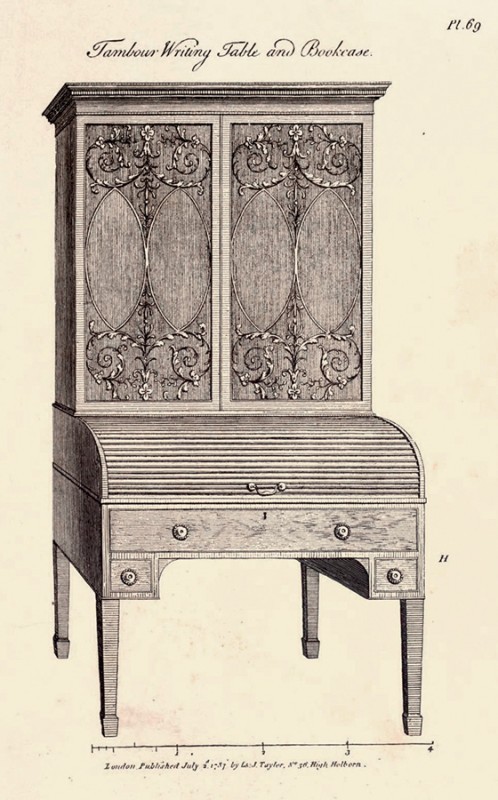
Design for a “Tambour Writing Table and Bookcase” illustrated on plate 69 of George Hepplewhite’s Cabinet-Maker and Upholsterer’s Guide (1788). (Courtesy, Winterthur Museum.)
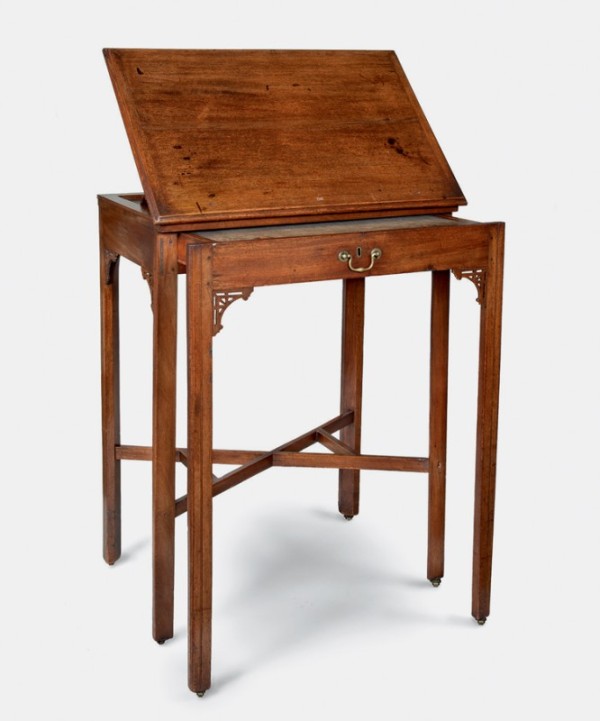
Standing desk, probably Williamsburg, Virginia, ca. 1770. Mahogany with yellow pine. H. 45 7/8", W. 36", D. 23". (©Thomas Jefferson Foundation at Monticello; photo, Gavin Ashworth.)
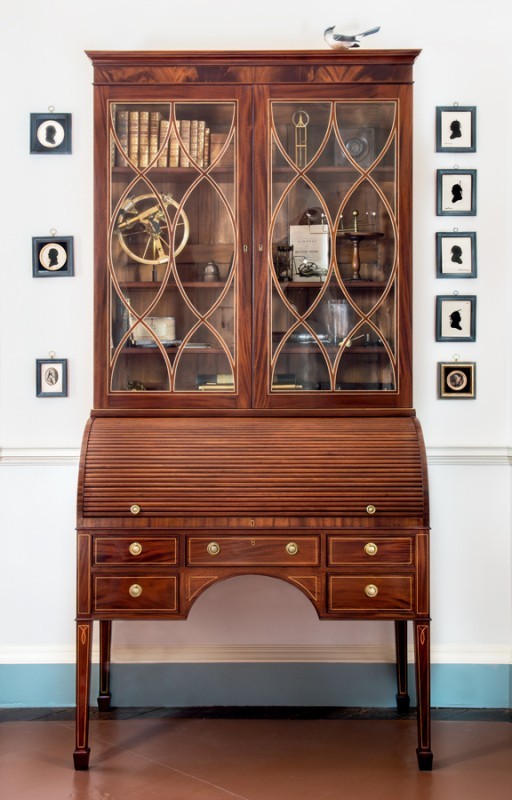
Harrison Higgins Jr., tambour writing table and bookcase, Richmond, Virginia, 2017. Mahogany and mahogany veneer with tulip poplar. H. 91 15/16", W. 44 1/4", D. 24". (©Thomas Jefferson Foundation at Monticello; photo, Gavin Ashworth.) This piece is modeled on an example from Thomas Burling’s shop.
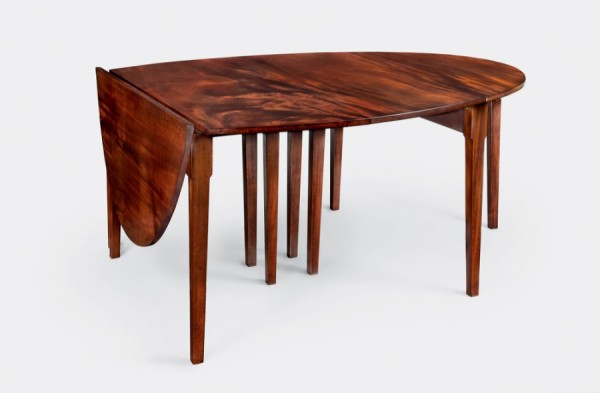
Robert R. Self, pair of dining tables from a set of seven, Albemarle County, Virginia, 1992. Mahogany with oak. Dimensions of pair closed: H. 29", W. 52", D. 4 3/8". (©Thomas Jefferson Foundation at Monticello; photo, Gavin Ashworth.) These tables, copies of the originals which are privately owned, have elliptical leaves, indicating they are end sections. Five rectangular sections could be introduced to make a larger table.

Thomas Jefferson, “Notes on a Tour through Holland and the Rhine Valley,” 1788. Ink on paper. (Courtesy, Thomas Jefferson Papers, Special Collections Research Center, William & Mary Libraries.)
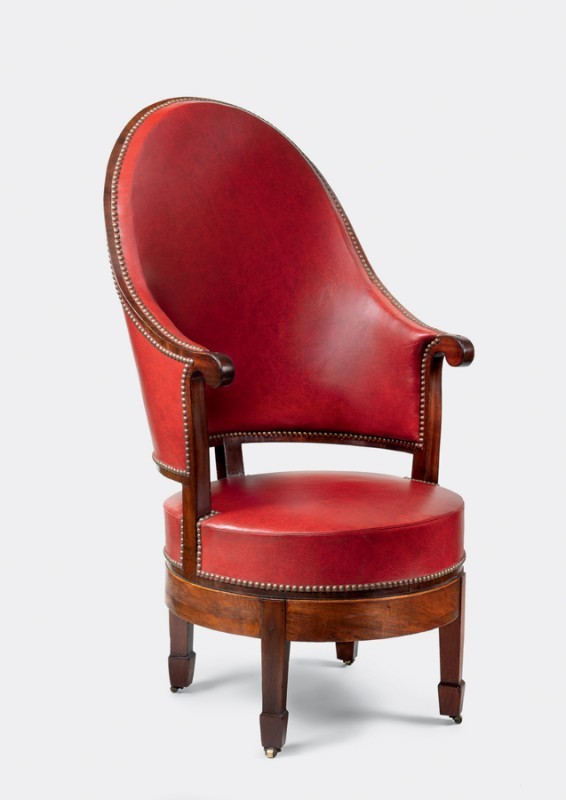
Thomas Burling, revolving armchair, New York City, 1790. Mahogany and mahogany veneer with ash; iron and brass. H. 48", W. 25 7/8", D. 31". (©Thomas Jefferson Foundation at Monticello; photo, Gavin Ashworth.)
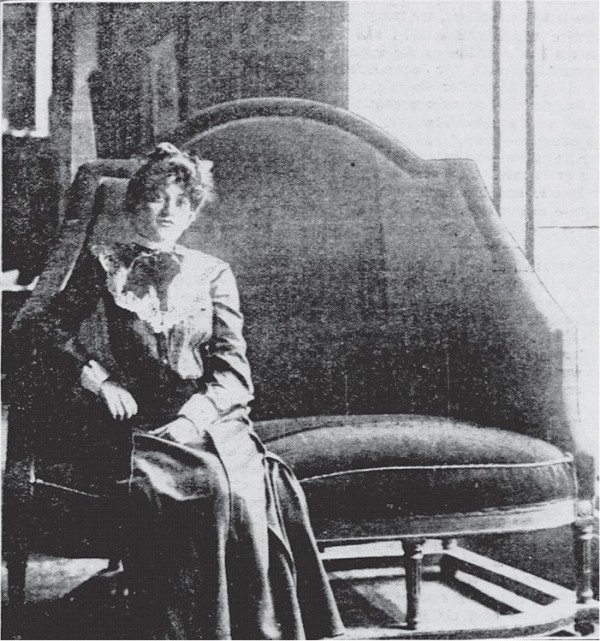
“250th Anniversary of New York City is also the 100th Anniversary of City Hall—Historic Relics which the Old Building Contains,” New York Tribune Illustrated Supplement, May 24, 1903. (Courtesy, Library of Congress.) The speaker’s or vice president’s chair was made by Thomas Burling in 1789.
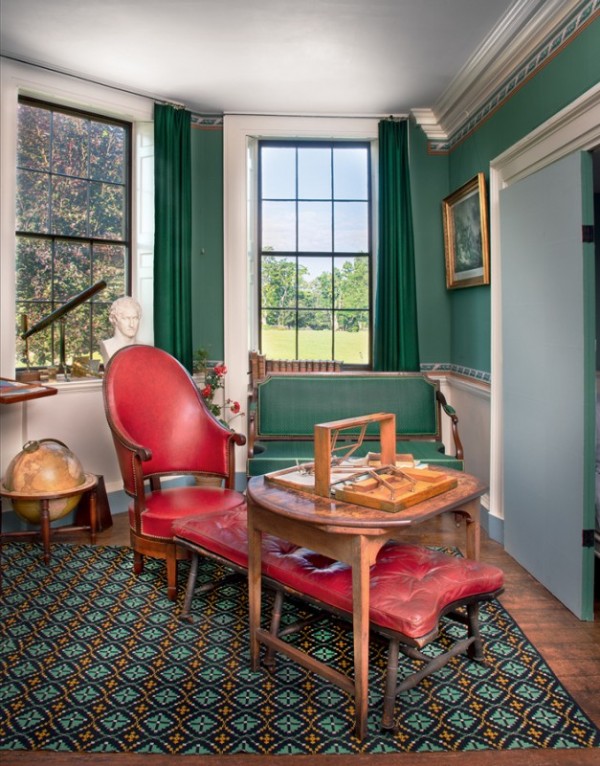
Cabinet, Monticello, Albemarle County, Virginia. (©Thomas Jefferson Foundation at Monticello; photo, Gavin Ashworth.) Burling’s shop made the revolving armchair, revolving stand, sofa, and possibly the frame of the revolving writing table.
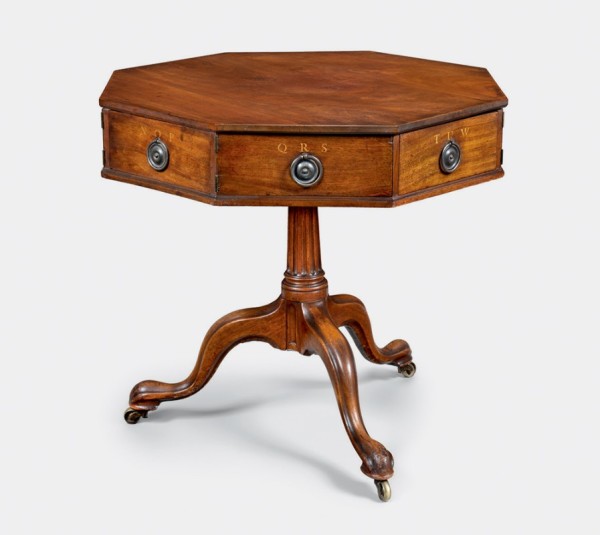
Thomas Burling, writing table, New York City, 1790. Mahogany with tulip poplar. H. 28 3/4", W. 33 1/4", D. 33 1/2". (Collection of the Massachusetts Historical Society; photo, Gavin Ashworth.)
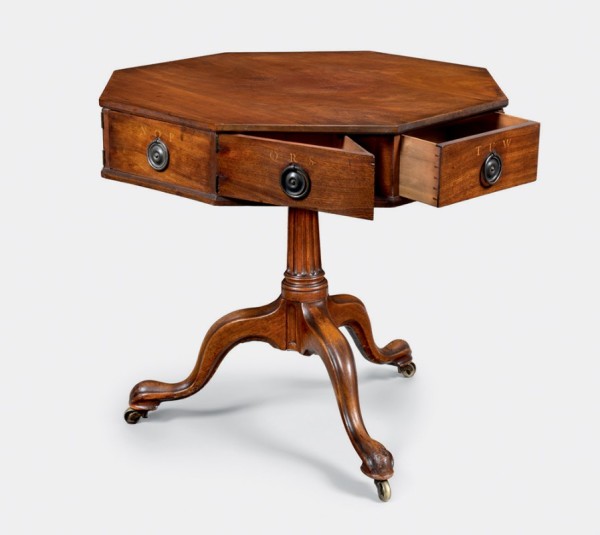
Detail showing the construction and drawers of the writing table illustrated in fig. 44.
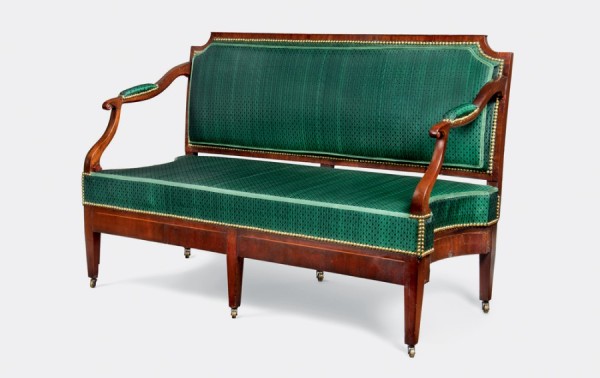
Thomas Burling, sofa, New York City, 1790. Mahogany and mahogany veneer with poplar. H. 38 1/2", W. 57 1/4", D. 27 1/2". (©Thomas Jefferson Foundation at Monticello; photo, Gavin Ashworth.)
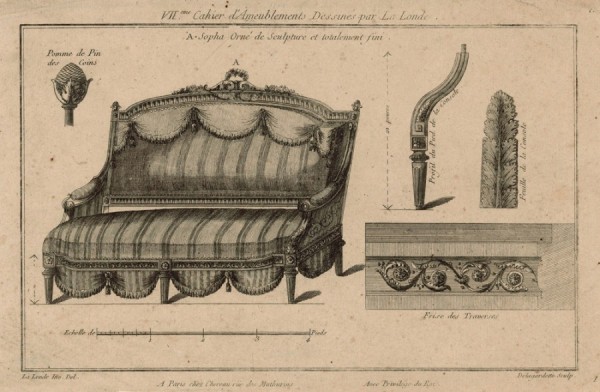
Design for a “Sopha orné de sculpture et totalment fini” illustrated in Richard de La Londe, Oeuvre diverses de LaLonde (1776–1788.), 2: ch. 7. (Courtesy, Rijksmuseum, Amsterdam.)
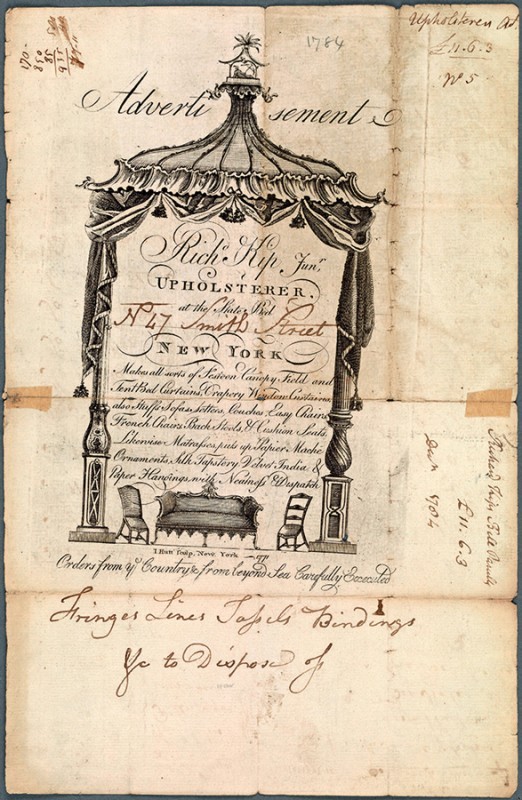
Advertisement for “Richard Kip Jr. Upholsterer,” New York City, ca. 1770. (Courtesy, New York Public Library.)
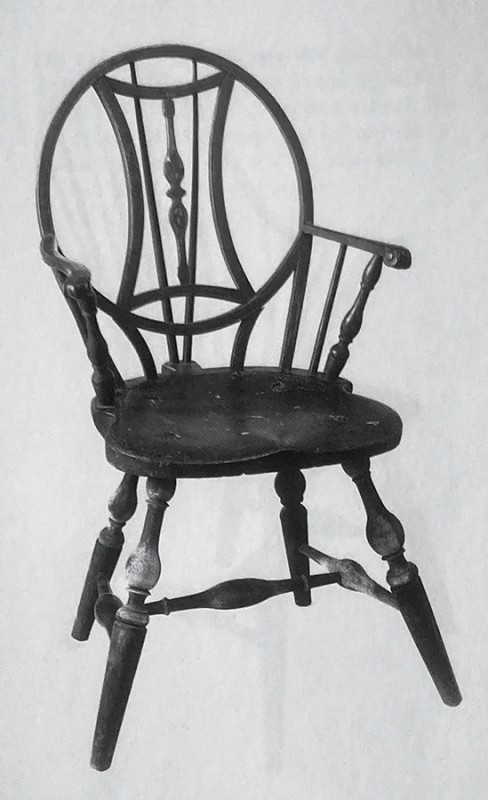
Windsor armchair, retailed by Richard Kip Jr., New York City, 1786–1790. (Private collection; photo, Winterthur Museum.) Remnants of Kip’s label appear under the seat.
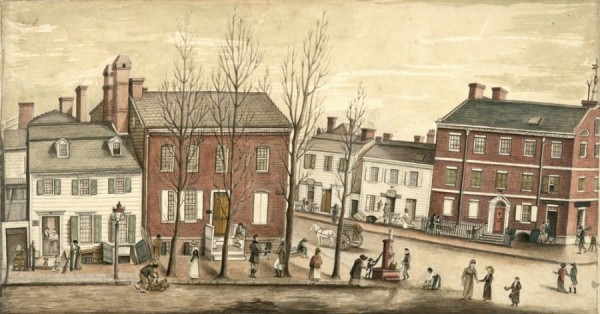
Anne-Marguerite-Henriette Hyde de Neuville, Corner of Greenwich, New York City, 1810. Pen, ink, and watercolor on paper. 7 5/16" x 13". (Courtesy, New York Public Library.)
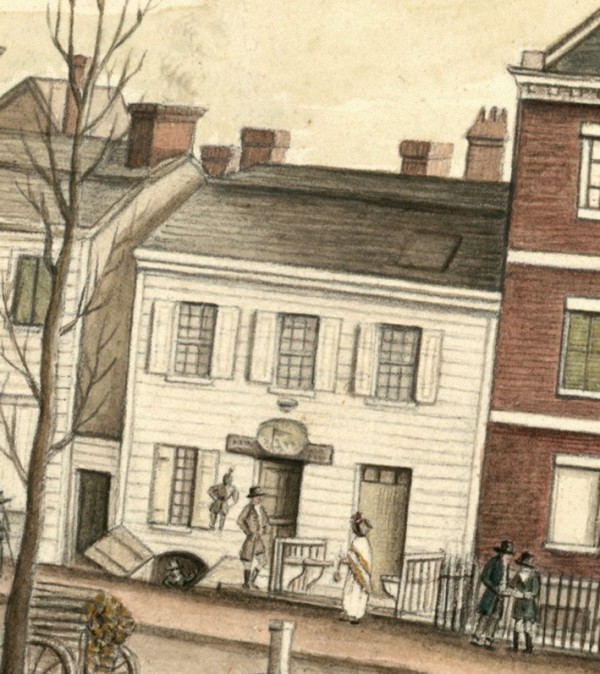
Detail of fig. 50, showing a three-bay house with a side passage like the one shown in Jefferson’s house plan in fig. 52.
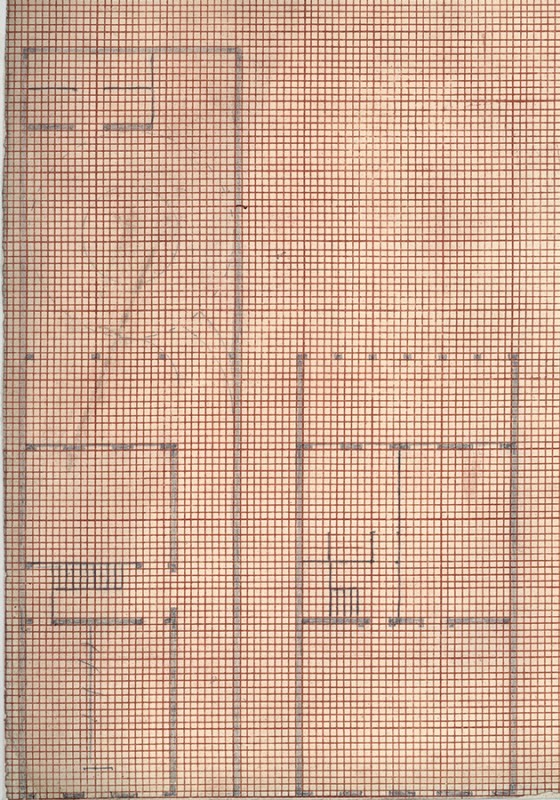
Thomas Jefferson, plan of the first and second floors of 57 Maiden Lane, New York City, 1790. Ink on paper. 9 1/8" x 11 15/16". (Collection of the Massachusetts Historical Society.)
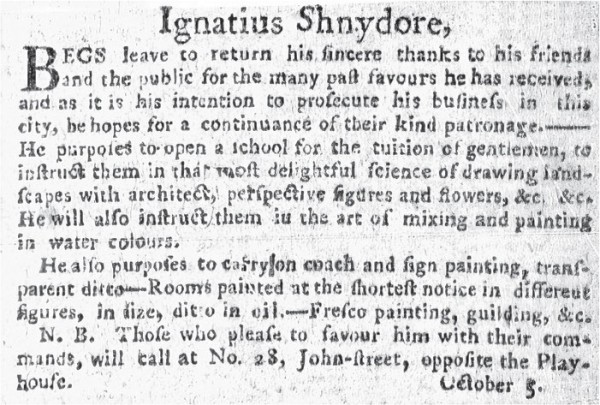
Advertisement for Ignatius Shnydore, Daily Advertiser, Political, Historical and Commercial (New York), October 5, 1789. (Courtesy, NewsBank/Readex.) Shnydore identifies fresco painting as one of his talents.
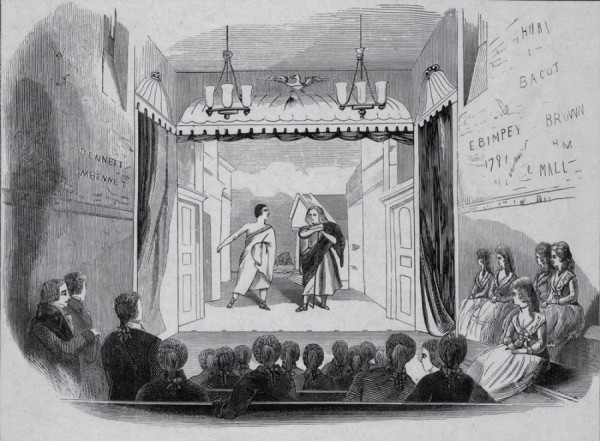
Two Figures in Roman Costume on Stage at the John Street Theater, New York City, ca. 1800–1850. Wood engraving. Ink on paper. 5 1/2" x 7 1/4". (Courtesy, New York Public Library.) This is a view of a classical play staged ca. 1791. The backdrop may be a representation of Shnydore’s perspective painting.
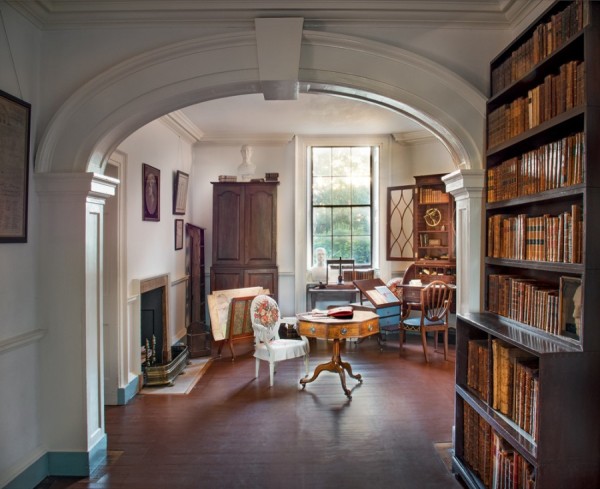
Library at Monticello, Albemarle County, Virginia. (©Thomas Jefferson Foundation at Monticello; photo, Gavin Ashworth.) Jefferson installed the New York furniture in his private suite.
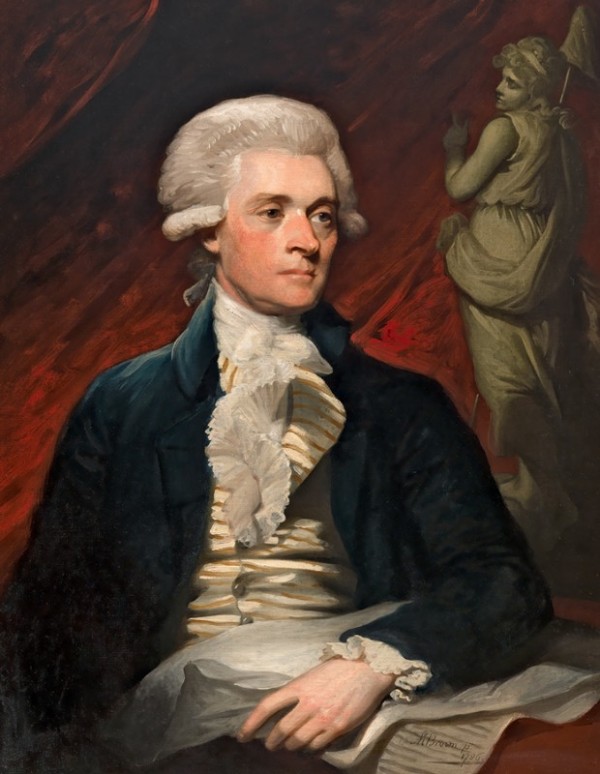
Mather Brown, Thomas Jefferson, London, 1786. Oil on canvas. 36" x 28". (Courtesy, National Portrait Gallery, Smithsonian Institution.) This painting portrays Jefferson when serving as minister to France.
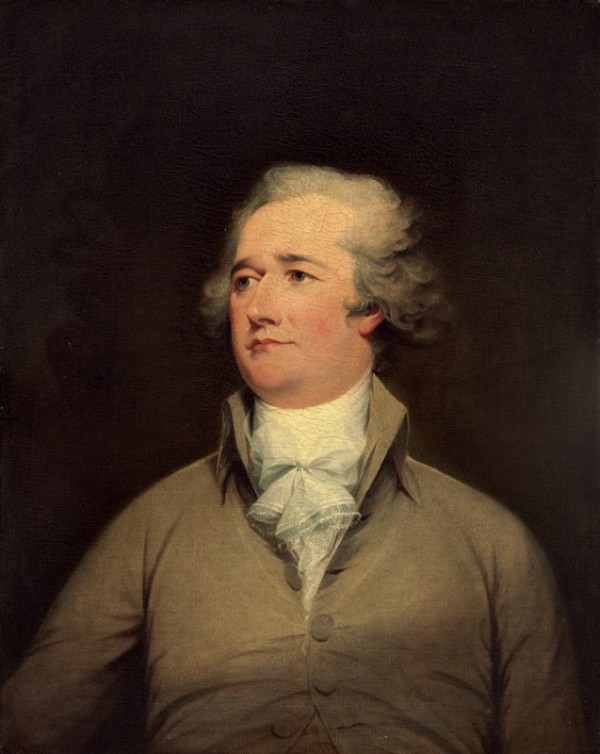
John Trumbull, Alexander Hamilton, New York, 1792. Oil on canvas. 30" x 23 13/16“. (Courtesy, National Gallery of Art.)
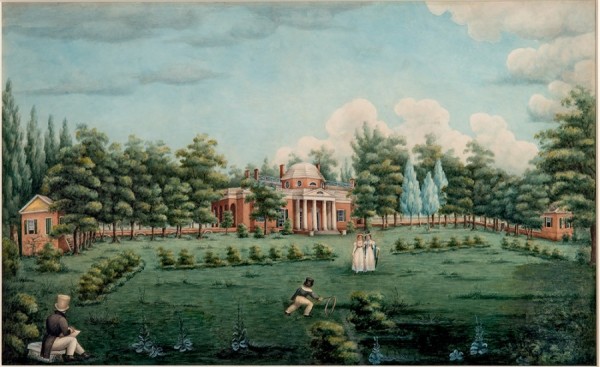
Jane Braddick Petticolas, View of the West Front of Monticello and Gardens, Virginia, 1825. Watercolor on paper. 13 5/8" x 18 1/8". (©Thomas Jefferson Foundation at Monticello.) This presents an idealized view of life at Monticello during the final years of Jefferson’s life.
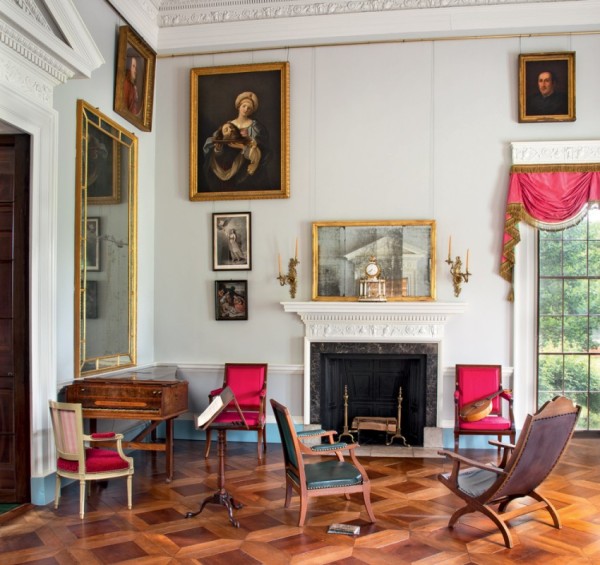
Parlor at Monticello, Albemarle County, Virginia. (©Thomas Jefferson Foundation at Monticello; photo, Gavin Ashworth.)
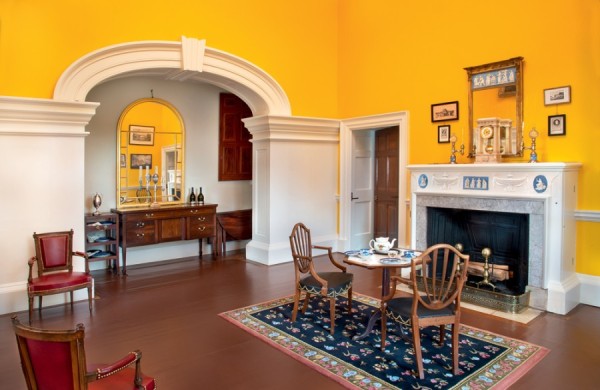
Dining room at Monticello, Albemarle County, Virginia. (©Thomas Jefferson Foundation at Monticello; photo, Gavin Ashworth.)
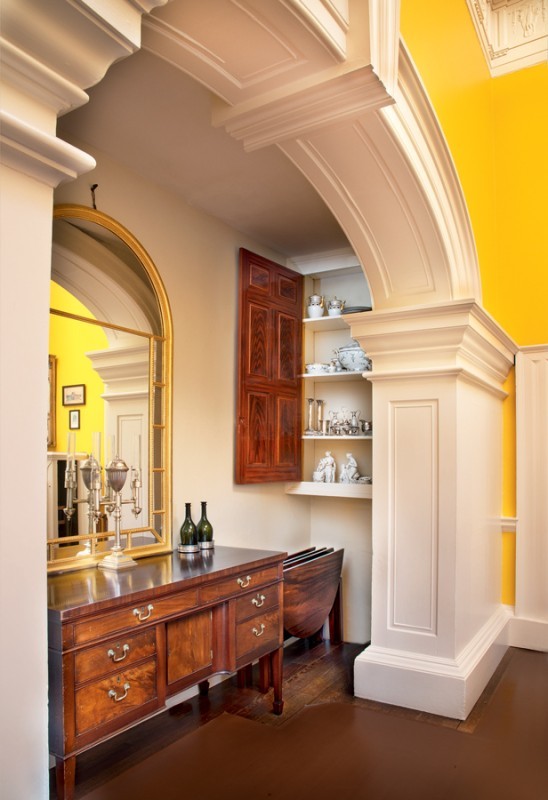
Alcove of the dining room illustrated in fig. 60. (©Thomas Jefferson Foundation at Monticello; photo, Gavin Ashworth.)
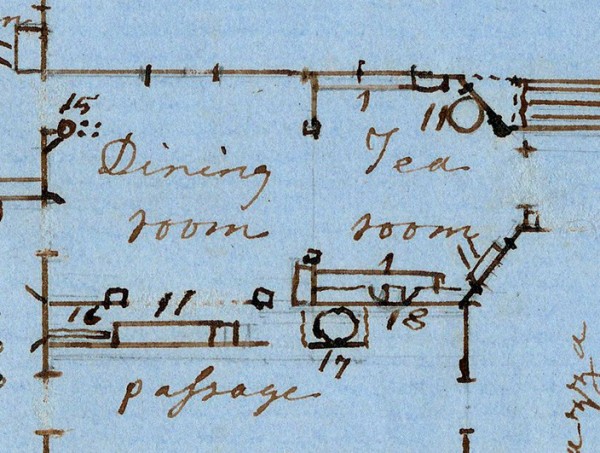
Cornelia Jefferson Randolph, “Plan of the First Floor of Monticello,” ca. 1826. Ink on paper. 8 1/4" x 13". (Courtesy, Albert and Shirley Small Special Collections Library, University of Virginia.) This detail shows how the console, sideboard (no. 11), and dining tables (no. 16) were stored in the dining room alcove.
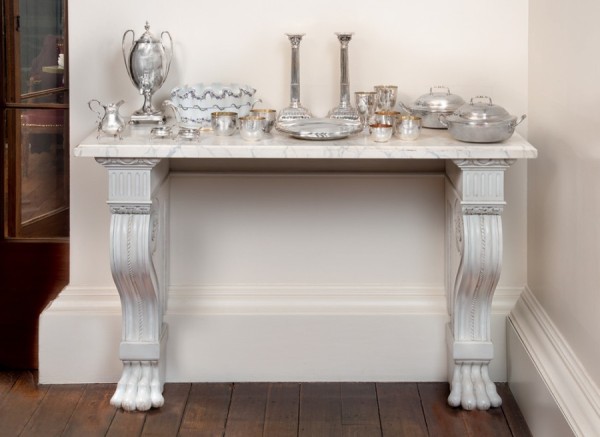
Harrison Higgins Jr., reproduction of a French console table. Richmond, Virginia, 2009. White pine with poplar. H. 34 1/2", W. 50", D. 20". (©Thomas Jefferson Foundation at Monticello; photo, Gavin Ashworth.)
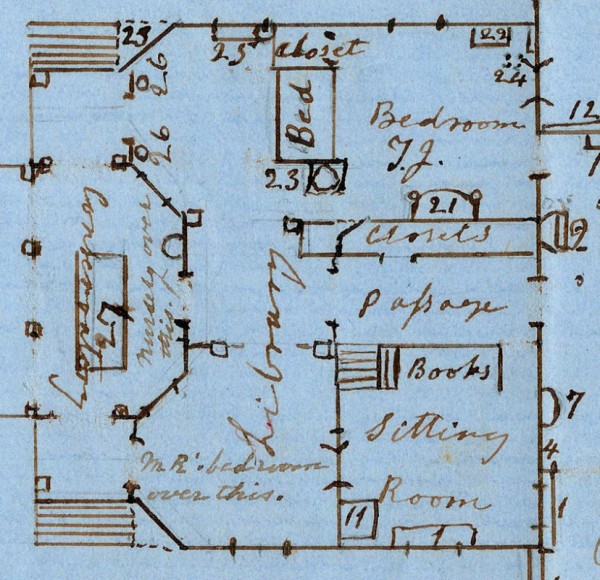
Cornelia Jefferson Randolph, “Plan of the First Floor of Monticello,” ca. 1826. Ink on paper. 8 1/4" x 13". (Courtesy, Albert and Shirley Small Special Collections Library, University of Virginia.) This detail shows the original location of the octagonal writing table surmounted by the square pupitre as well as the overall arrangement of Jefferson’s private suite. The sofa attributed to Burling is no. 25 on the plan, situated in the cabinet.
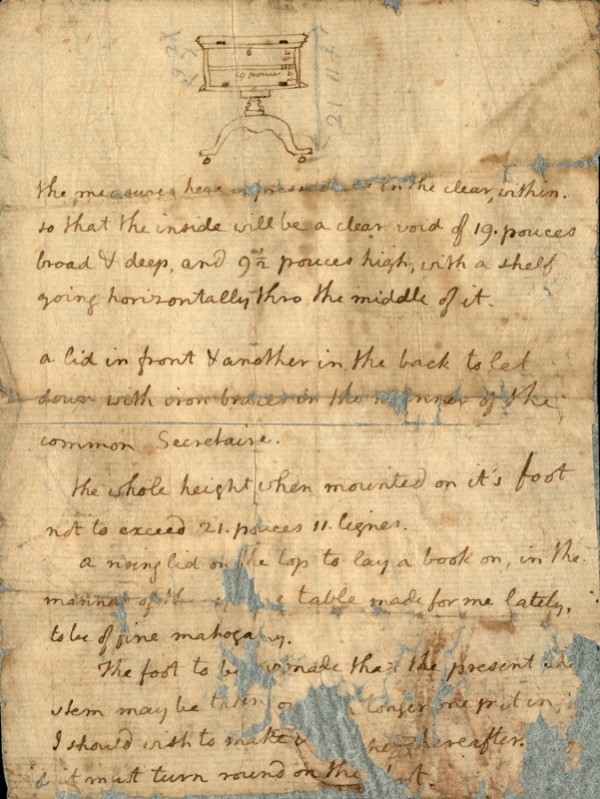
Thomas Jefferson, “Design for a Desk,” Paris, ca. 1785. Pen and ink on paper. 4 1/2" x 6". (Courtesy, Albert and Shirley Small Special Collections Library, University of Virginia.) This is Jefferson’s commission drawing and notes for his pupitre, used to record and store correspondence.
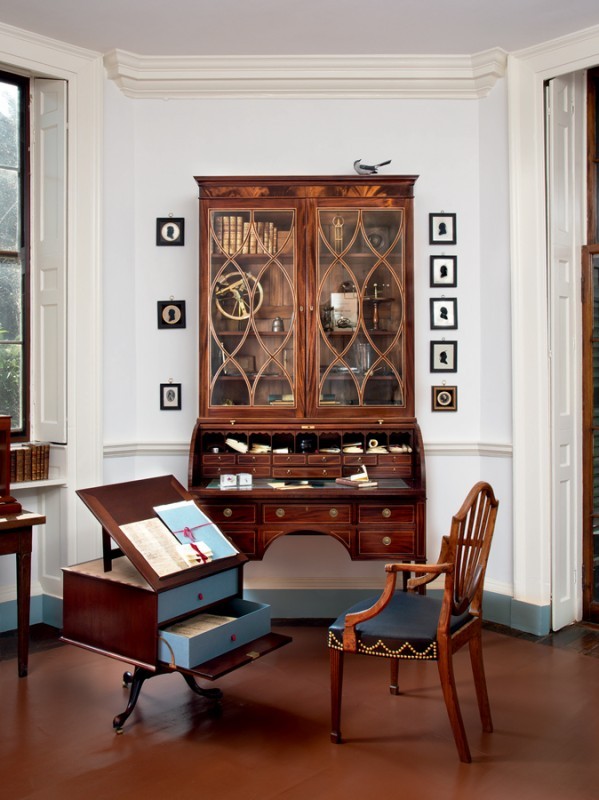
Harrison Higgins Jr., reproduction pupitre, Richmond, Virginia, 2017. Mahogany with tulip poplar. H. 22 3/8", W. 20", D. 20". (©Thomas Jefferson Foundation at Monticello; photo, Gavin Ashworth.) The original object has not been located.
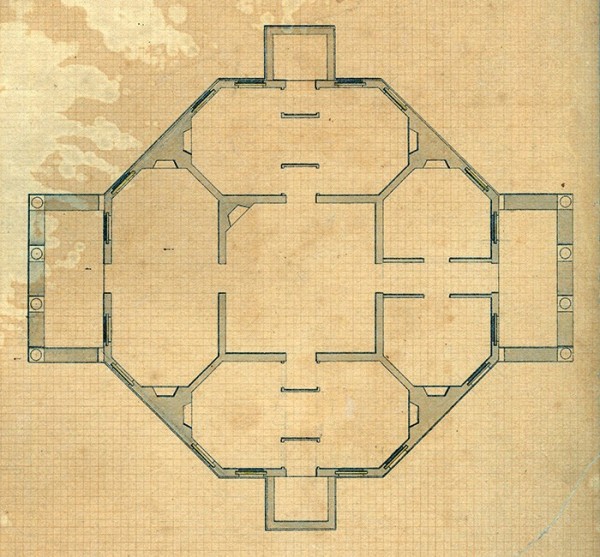
John Neilson, “Plan of Poplar Forest,” Bedford County, Virginia, 1819. India ink on hand-ruled graph paper. 11 1/2" x 9". (Courtesy, Albert and Shirley Small Special Collections Library, University of Virginia.)
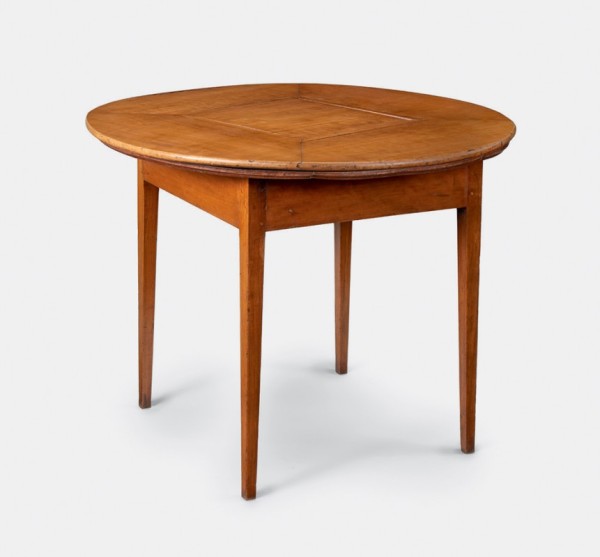
Revolving table, attributed to John Hemmings, Monticello, Albemarle County, Virginia, ca. 1815. Cherry and walnut with yellow pine. H. 28 1/2", D. 35 3/4". The top features an inlaid square in contrasting wood. (©Thomas Jefferson Foundation at Monticello; photo, Gavin Ashworth.)
